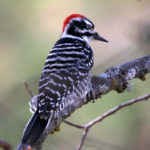Learning the common birds around you is one of the best ways to appreciate nature. Birds are a “value-added” feature of any region, and knowing the birds often results in a deeper knowledge of your local environment.
When used as a supplement to a good bird guide, the forthcoming Birding Sites of Stanislaus and Merced Counties, from Stanislaus Audubon, will make learning local birds even easier. Meanwhile, there’s a short essay on fundamentals for beginners here. Basically, there are two keys to learning the common birds around you: (1) narrow your focus and (2) use the target method.
When you narrow your focus, you don’t worry about all the birds in the bird book. Instead, you set out to learn only the birds you are most likely to see in your neighborhood or region. While well over six-hundred species of birds have been found in California, only slightly more than three-hundred have been found in Stanislaus and Merced Counties. When we focus on woodpeckers here in the flatlands of the Northern San Joaquin Valley, only three are common: Nuttall’s, Acorn, and Downy.
Once you’ve placed a bird into its proper grouping—woodpecker, sparrow, duck, etc.—use the target method to target a bird or birds you are statistically most likely to see. And while over half a dozen different woodpecker species have been seen in our area, only Nuttall’s, Downy and Acorn are common. So if you see a woodpecker, chances are it’s one of these three. Look for the Nuttall’s Woodpecker when you go outside while remembering the other two.
Each of these species has distinctive features. The Nuttall’s Woodpecker has a “ladder back” formed of black and white bars. Just don’t confuse it with the Ladder-backed Woodpecker, a similar species that occurs in our southern deserts. The Acorn Woodpecker has a “clown” face, and the Downy Woodpecker a white striped back. So all we have to remember for woodpeckers is, “ladder back, clown face and white stripe.”
In your bird guide, study the three woodpeckers until you can recall, “ladder back, clown face and white stripe.” Next, try to get a sense of the “chrrt” sound made by Nuttall’s Woodpeckers. You can find the sound here. Once you have a good idea of the Nuttall’s call and appearance, look for the bird in one of our local parks. The Nuttall’s Woodpecker can be found on almost any tree from an oak to a willow and in between. They are usually heard first, then seen climbing a branch or trunk. Despite the bold black and white pattern, they can be hard to see.
While looking for the Nuttall’s Woodpecker, there’s a good chance of encountering Acorn Woodpeckers. With their bold coloration, loud calls (they sound like maniacal laughter) and constant activity, Acorn Woodpeckers are usually our most conspicuous woodpecker.
It’s well within most people’s capabilities to learn one-hundred or more of the common birds in their neighborhood or region. We’ll be offering short cuts to learning the birds here in the Northern San Joaquin Valley. For now, the target bird is the Nuttall’s Woodpecker, but with good luck you might achieve a “Woody Trifecta” and see “ladder back, clown face and white stripe,” on the same outing.


Thanks!
I’ll forward this to my birding friends — thanks!
HI, Eric, We enjoy seeing and hearing Nuttall’s woodpeckers in our old oak neighborhood in Sacramento too. Sometimes one comes to my bird bath, He is a very shy and schizzy bather.
This is a very helpful article. I enjoy birdwatching and I keep a hummingbird feeder out all the time. Since I have moved to San Diego, I recently discovered there are ferrel parrots here, they don’t come close enough to see because they stay high in the palm trees, but I can hear and see them fly by from a distance. Any suggestions on how to lure them into my patio for a closer look?
Good Morning, The woodpeckers in my neighborhood have bright orange on both sides of their face. Do you know what type of woodpecker they are? Thank You, Kathleen
Hi Kathleen,
Sounds like you have Northern (Red-shafted) Flickers. Google Northern Flicker and see whether the images match your birds.
I just discovered a Nuttall Woodpacker in our backyard tree located in the Palm Springs, CA area. Beautiful to watch as he (has a red crown) keep packing at the branches. I wish I could keep one in a birdcage.